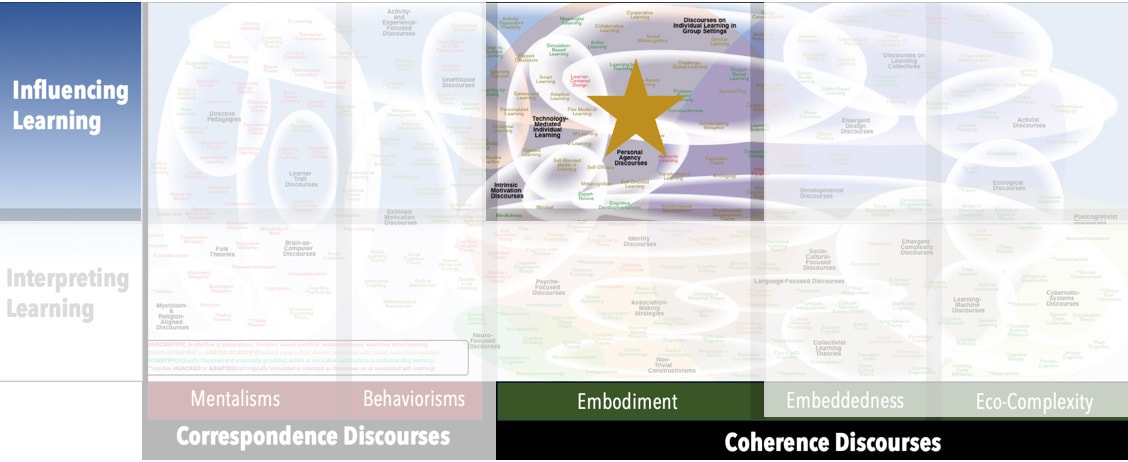Focus
Individual generating meaning of social contextsPrincipal Metaphors
- Knowledge is … web of associations
- Knowing is … associating appropriately
- Learner is … an associator
- Learning is … making associations
- Teaching is … prompting associations; mediating; capitalizing on the learner’s compulsion to make sense
Originated
Ancient; formalized as a principle in 1970sSynopsis
Rooted in social psychology, the Sensemaking Metaphor addresses the ways that people derive meaning from and assign meaning to experiences. The following are among the grounding principles of the Sensemaking Metaphor: who one is, what one does, and how one thinks are inseparable; sensemaking is a social and situated activity; collectives unfold from and are enfolded in individuals; sensemaking is always happening; people tend to favor established belief over physical demonstration. Many pedagogical approaches have been explicitly based on this metaphor, including:- Cognitive Acceleration (Michael Shayer, Philip Adey; 1980s) – Asserted to be rooted in Piaget’s Genetic Epistemology and Vygotsky’s Socio-Cultural Theory, Cognitive Acceleration positions the teacher as a mediator in a process usually characterized as “guided self-discovery.” The teacher-mediator’s principal role is to structure tasks and insert timely prompts to support learners as they make sense of exploration-based situations.
- Elaborative Interrogation (Tim Seifert, 2010s)– asking higher-level questions (e.g., Why? How?) about a new idea – which, in terms of the Sensemaking Metaphor, helps to make connections to while further developing established understandings
- Impasse-Driven Learning (Kurt VanLehn, 1980s) – a process whereby one encounters a problem ("impasse") in their understanding of a topic, prompting efforts to seek out and engage with relevant information or resources to overcome that obstacle. Impasse-driven learning emphasizes targeted support, reflection, and problem-solving.
- Paraphrasing Practice (Summarization Practice) – restating a new idea in one’s own words – or, in terms of the Sensemaking Metaphor, drawing on one’s established associations to reweave an idea
- Personal Theories (1980s) – personally coherent interpretations of concepts, physical happenings, and other phenomena. Within some educational philosophies, Personal Theories are encouraged, with the intention to prompt learner interpretations toward more broadly accepted perspectives.
- Self-Explanation (Think-Alouds) (Michelene T.H. Chi, 1980s) – explaining how a new idea relates to one’s established knowledge – which, in terms of the Sensemaking Metaphor, helps to knit the idea into one’s web of associations. Associated constructs include:
- Self-Explanation Effect – a reference to the educational benefits of Self-Explanation, which are reputed to be cognitive, affective, and social in nature
- Sensemaking Trajectory – Derived by blending the Sensemaking Metaphor and the notion of Learning Trajectory (see Attainment Metaphor), a Sensemaking Trajectory is, effectively, a sequence of experiences designed to support the development of a robust understanding of a specific concept.
Commentary
The Sensemaking Metaphor is typically presented/engaged as a literal description (rather than a figurative interpretation) of what is going on when learning happens. As such, it lacks some critical elements of a full-blown theory, even though it shares some core assumptions and assertions with prominent Embodiment Discourses and Embeddedness Discourses.Authors and/or Prominent Influences
Daniel Katz; Robert L. Kahn; Karl WeickStatus as a Theory of Learning
The Sensemaking Metaphor is not a theory of learning. Rather than engaging critically with the metaphoric entailments of “sensemaking,” the notion is typically presented/engaged as a literal description of what is going on when learning happens. Lacking such elements, the Sensemaking Metaphor tends to operate more as a principle of learning than a broader theory.Status as a Theory of Teaching
Advocates of the Sensemaking Metaphor have assembled some fine-grained advice on supporting sensemaking and using it as a fulcrum for positively affecting organizational dynamics. While not a theory of teaching, then, the Sensemaking Metaphor has proven to be a useful lens to view, interpret, and inform teaching situations.Status as a Scientific Theory
The Sensemaking Metaphor is a figurative suggestion that might be taken up by scientific theories, but that itself cannot be construed as a scientific theory.Subdiscourses:
- Cognitive Acceleration
- Elaborative Interrogation
- Impasse-Driven Learning
- Paraphrasing Practice (Summarization)
- Personal Theories
- Self-Explanation (Think-Alouds)
- Self-Explanation Effect
- Sensemaking Trajectory
Map Location

Please cite this article as:
Davis, B., & Francis, K. (2024). “Sensemaking Metaphor” in Discourses on Learning in Education. https://learningdiscourses.com.
⇦ Back to Map
⇦ Back to List
